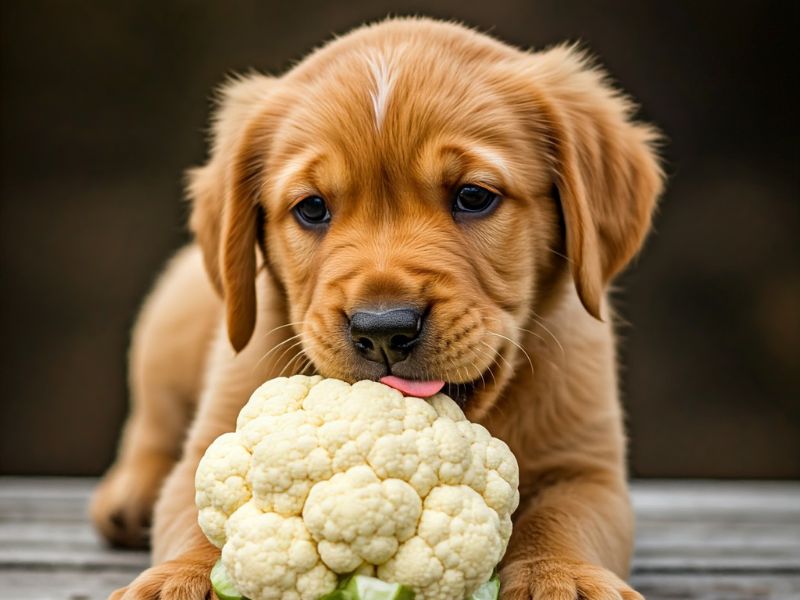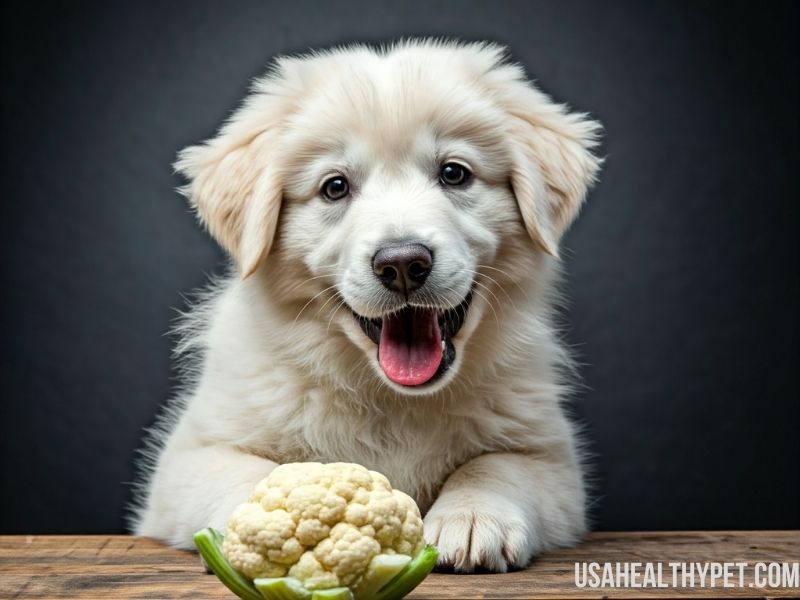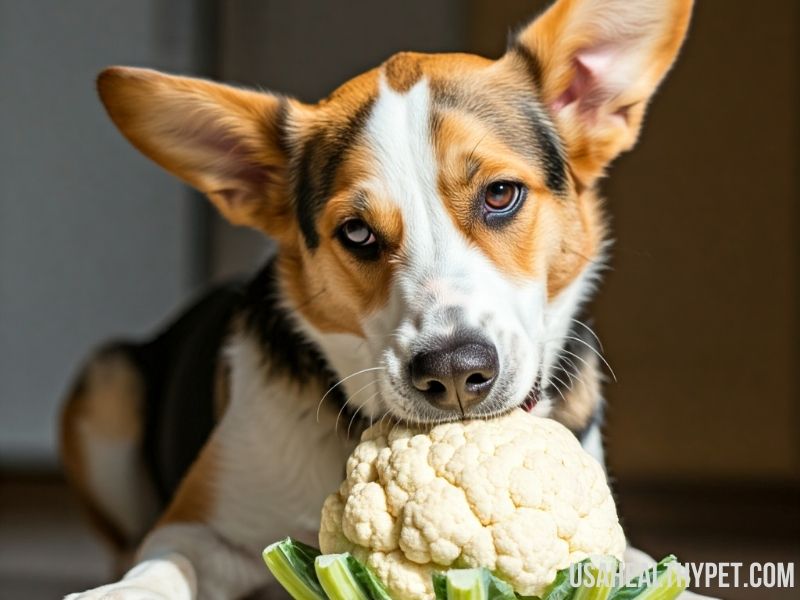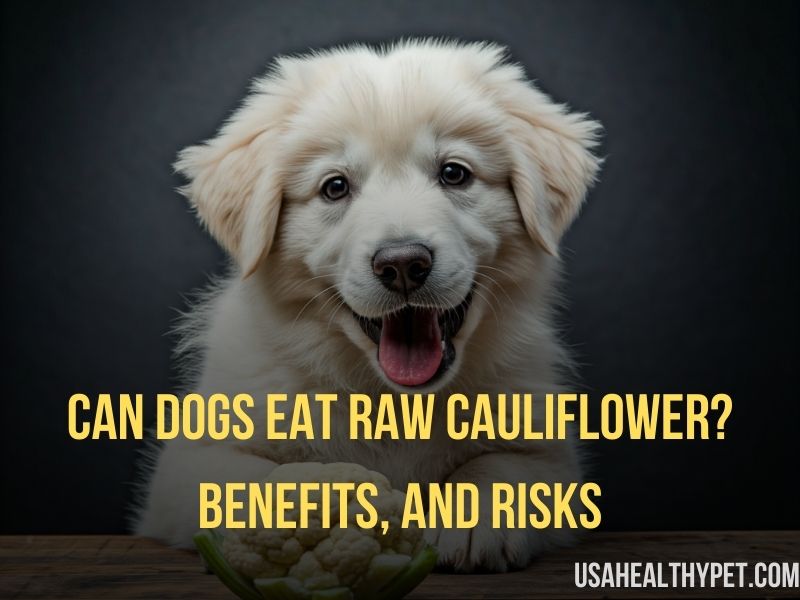Introduction: Can Dogs Safely Eat Cauliflower?
Dogs are curious creatures, often interested in sampling whatever you’re eating. If cauliflower is on your plate, you may wonder: can my dog eat cauliflower, especially raw?
The simple answer is yes, dogs can eat cauliflower, both raw and cooked, but there are a few things to consider for your dog’s health and comfort.
In this guide, we’ll dive into everything you need to know about feeding cauliflower to your furry friend. Let’s explore the benefits, the downsides, and the best ways to introduce cauliflower to your dog’s diet.
What Are the Nutritional Benefits of Cauliflower for Dogs?
Cauliflower is packed with vitamins and nutrients, making it a healthy treat for dogs in moderation. Here are some of the key nutrients your dog can benefit from:
- Vitamin C: This antioxidant is excellent for a dog’s immune system and can aid in fighting off infections.
- Fiber: Just like for humans, fiber is essential for good digestion in dogs. It can help regulate bowel movements and prevent constipation.
- Vitamin K: Essential for healthy blood clotting and bone health, Vitamin K is a small but mighty nutrient.
- Folate: Folate plays a vital role in cell function and tissue growth, supporting your dog’s overall health.
- Low in Calories: Cauliflower is low in calories, making it an ideal snack for dogs that need to watch their weight.
These nutrients make cauliflower a great addition to your dog’s diet, as long as it’s given in controlled amounts.
According to Dr. Jerry Klein, cauliflower is a low-calorie, nutrient-packed treat that offers valuable vitamins and minerals for dogs, including vitamin C, vitamin K, and folate.

Raw vs. Cooked Cauliflower: Which is Better for Dogs?
One of the biggest questions dog owners have is whether to serve cauliflower raw or cooked. While both forms are generally safe, they have some differences:
- Raw Cauliflower: Raw cauliflower is crunchy, making it enjoyable for some dogs to chew. However, it can be harder for dogs to digest and may lead to gas and bloating if eaten in large amounts.
- Cooked Cauliflower: Cooking cauliflower softens it, making it easier for dogs to digest. Steaming or boiling without adding any oils, butter, or seasonings is the best way to prepare cauliflower for dogs.
Dr. Kristi Flynn, a veterinarian, suggests that cooked cauliflower is generally easier for dogs to digest than raw. She explains that steaming or boiling cauliflower softens its fibrous structure, making it gentler on a dog’s digestive system. This can be particularly helpful for dogs with sensitive stomachs.
So, which is better? If your dog has a sensitive stomach, cooked cauliflower may be the safer choice.
But if your dog enjoys crunching on raw veggies and doesn’t seem to have any digestive issues, small amounts of raw cauliflower can be fine.
Is Raw Cauliflower Safe for Dogs to Eat?
Yes, raw cauliflower is safe for dogs to eat, but it should be given in moderation. Raw vegetables can sometimes be tough on a dog’s digestive system, especially if they’re not used to high-fiber foods.
If you’re thinking about introducing raw cauliflower into your dog’s diet, start with very small portions to see how your dog responds.
Cauliflower, whether raw or cooked, should be offered as an occasional treat rather than a meal replacement.
Dogs have specific nutritional needs that cauliflower alone cannot meet, so it’s best to treat it as a snack rather than a dietary staple.
Potential Risks of Feeding Raw Cauliflower to Dogs
While cauliflower is safe for most dogs, there are a few risks you should be aware of:
- Gas and Bloating: Cauliflower contains a type of carbohydrate called raffinose, which can lead to gas and bloating in dogs (and people). If your dog has a sensitive stomach, raw cauliflower may lead to some discomfort.
- Digestive Upset: For dogs that aren’t accustomed to raw veggies, cauliflower might cause digestive upset, leading to symptoms like diarrhea or vomiting.
- Choking Hazard: Larger pieces of raw cauliflower can pose a choking risk, especially for smaller dogs. Always cut cauliflower into bite-sized pieces before serving it to your pet.
To minimize risks, start with small amounts and observe how your dog reacts. If they show any signs of discomfort, it’s best to discontinue feeding them cauliflower and consult your vet if needed.

How to Introduce Cauliflower to Your Dog’s Diet
Introducing cauliflower to your dog’s diet doesn’t have to be complicated. Here’s a step-by-step approach:
- Start Small: Begin with a tiny portion, about a teaspoon, and see how your dog reacts over the next 24 hours.
- Observe for Reactions: Check for any signs of bloating, gas, or digestive issues. If your dog shows any discomfort, it may be best to avoid raw cauliflower in the future.
- Adjust Serving Size: If your dog tolerates the cauliflower well, you can gradually increase the portion size, but keep it to a few bite-sized pieces to avoid overfeeding.
- Mix it Up: Try mixing cauliflower with other dog-safe vegetables like carrots or broccoli to provide variety.
Consistency is key. Stick to a set portion size and avoid giving cauliflower too frequently to prevent any digestive disruptions.
Signs of Digestive Issues in Dogs After Eating Cauliflower
Studies from the National Research Council (NRC) emphasize the importance of dietary fiber in a dog’s diet, noting that fiber helps maintain regular digestion. The fiber in cauliflower, for instance, can aid digestion but also potentially cause gas if given in large amounts.
It’s essential to monitor your dog for signs of digestive issues after they eat cauliflower, especially if they’re new to it. Here are some symptoms to watch for:
- Excessive Gas: A little gas can be normal, but if your dog seems uncomfortable, it might be a sign cauliflower isn’t agreeing with them.
- Vomiting or Diarrhea: Any vomiting or loose stools could mean cauliflower is too hard on their stomach.
- Loss of Appetite: If your dog refuses food after eating cauliflower, it might be due to a stomach ache.
If any of these symptoms appear and don’t go away within a day or so, it’s best to contact your vet for advice. They can help you determine if cauliflower should be off your dog’s menu.
What to Do If Your Dog Eats Too Much Cauliflower
Did your dog sneak a large amount of cauliflower? Don’t panic! Most of the time, they’ll be okay, but here are some steps to follow:
- Monitor Them Closely: Keep an eye out for any signs of digestive discomfort, such as bloating, gas, or unusual behavior.
- Encourage Hydration: Drinking water can help with digestion and may ease any stomach discomfort.
- Provide a Calm Environment: Sometimes, dogs can become anxious if they feel unwell, so keeping them relaxed can help.
- Contact the Vet if Necessary: If your dog shows signs of severe discomfort, vomiting, or diarrhea that doesn’t improve, it’s time to give your vet a call.

Other Vegetables That Are Safe for Dogs
Looking to add more variety to your dog’s diet? Here are some dog-friendly veggies that are safe and nutritious in moderation:
- Carrots: Crunchy and sweet, carrots are a favorite for many dogs.
- Broccoli: High in fiber and Vitamin C, but also best in moderation to avoid gas.
- Green Beans: A low-calorie snack that many dogs enjoy.
- Sweet Potatoes: Full of fiber and Vitamin A, but only give them cooked and plain.
Remember to always introduce new vegetables gradually and in small amounts.
Conclusion: Should You Feed Your Dog Cauliflower?
So, can dogs eat cauliflower raw? Yes, they can, but it’s all about moderation. Cauliflower can be a nutritious and low-calorie treat for your dog, packed with vitamins and fiber.
Just keep portions small and always monitor for any digestive issues.
If you decide to feed your dog raw cauliflower, start with a small amount, cut it into bite-sized pieces, and keep an eye out for any signs of discomfort.
Ultimately, while cauliflower is safe and healthy, it should only be an occasional snack, not a regular meal component.
FAQs
1. How much cauliflower can I give my dog?
Start with a small piece, about the size of a teaspoon, and see how your dog reacts. For larger dogs, you can give a bit more, but avoid giving too much to prevent gas and bloating.
2. Can puppies eat raw cauliflower?
It’s best to avoid giving puppies raw cauliflower, as their digestive systems are still developing. If you want to introduce cauliflower, opt for cooked and in tiny amounts.
3. Are there any vegetables dogs should avoid?
Yes, some vegetables like onions, garlic, and leeks are toxic to dogs and should never be fed to them.
4. Can raw cauliflower cause allergies in dogs?
It’s rare, but possible. If your dog shows signs of an allergic reaction, like itching, swelling, or hives, stop feeding them cauliflower and consult your vet.
5. Can cauliflower help dogs with weight loss?
Yes, cauliflower is low in calories and can be a healthy, filling treat for dogs on a weight-loss plan. Just remember to keep portions small.
